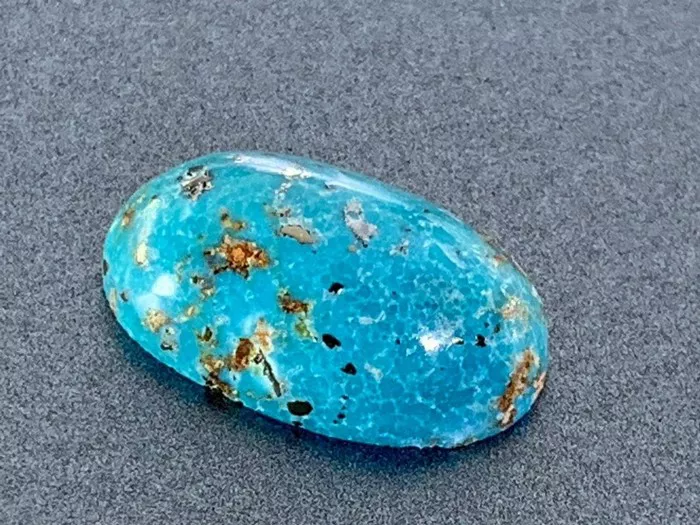Turquoise is a captivating gemstone renowned for its stunning blue-green hues and cultural significance dating back centuries. This gemstone has been cherished by civilizations such as the Ancient Egyptians, Native Americans, and Persians for its beauty and believed mystical properties. Turquoise is often associated with protection, healing, and good fortune, making it a sought-after gem in jewelry making and spiritual practices.
Visual Inspection Tips:
Real turquoise exhibits a range of colors, from sky blue to deep green, with variations in matrix patterns caused by the presence of other minerals like copper or iron. Look for natural imperfections called “matrix” or “veining,” which are characteristic of genuine turquoise. Avoid perfectly uniform colors or overly smooth textures, as these can indicate synthetic or imitation materials.
Physical Tests:
Scratch Test: Use a sharp object like a needle or knife to gently scratch the surface of the bead. Genuine turquoise is relatively soft (5-6 on the Mohs scale), so it should show a scratch mark. Be cautious not to damage the bead excessively.
Weight Comparison: Real turquoise is denser than most imitations. Compare the weight of the bead to a known genuine turquoise bead of similar size. If there’s a significant difference, it may indicate a fake.
Temperature Feel: Genuine turquoise feels cool to the touch, even in warmer environments. Place the bead against your skin or lips to assess its temperature. Synthetic materials may feel warmer or have a plastic-like texture.
Price Evaluation:
Authentic turquoise comes with a price tag that reflects its rarity and quality. Be wary of extremely low prices, especially for larger or high-grade turquoise beads, as they could be indicative of fake or low-quality materials. Factors such as color intensity, clarity, and origin can also influence the price range, with top-quality turquoise fetching premium prices.
Stabilized vs. Reconstituted Turquoise:
Understanding the difference between stabilized and reconstituted turquoise is crucial in identifying real turquoise:
Stabilized Turquoise: This is genuine turquoise that has undergone a stabilization process to enhance its durability and color. Stabilization involves infusing the stone with resins or polymers to fill any pores or cracks, resulting in a more resilient gemstone. While still genuine, stabilized turquoise may have a slightly different appearance and is often more affordable than untreated turquoise.
Reconstituted Turquoise: Reconstituted turquoise is made from small turquoise fragments or powder mixed with binding agents to create a composite material. It lacks the natural integrity and properties of genuine turquoise and is considered an imitation or synthetic product.
Common Imitations:
Several materials are commonly used to imitate turquoise beads, including:
Dyed Howlite: Howlite, a naturally white or gray mineral, is often dyed blue or green to mimic turquoise. However, its lack of natural veining and lower hardness compared to turquoise make it distinguishable upon closer inspection.
Magnesite: Magnesite is another mineral that can be dyed to resemble turquoise. It tends to have a smoother texture and less pronounced matrix patterns than real turquoise.
Certification and Documentation:
When purchasing turquoise beads or jewelry, prioritize buying from reputable sellers who provide Gemological Institute of America (GIA) certifications or similar documentation verifying the authenticity of the gemstones. These certificates ensure that the turquoise is genuine and may include details about its origin and treatment, if any.
Care and Maintenance:
To preserve the authenticity and beauty of turquoise jewelry, follow these care tips:
Avoid Harsh Chemicals: Keep turquoise away from chemicals such as household cleaners, perfumes, and cosmetics that can damage its surface or alter its color.
Store Properly: Store turquoise jewelry in a soft pouch or cloth to prevent scratches and minimize exposure to sunlight, which can fade its color over time.
Regular Cleaning: Gently clean turquoise beads with a soft, damp cloth to remove dirt and oils. Avoid using abrasive cleaners or brushes that can scratch the surface.
By combining visual inspection techniques, basic physical tests, knowledge of common imitations, and adherence to certification standards, you can confidently distinguish between real turquoise beads and their synthetic counterparts. Remember to care for your turquoise jewelry diligently to enjoy its beauty and authenticity for years to come.


